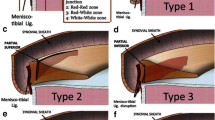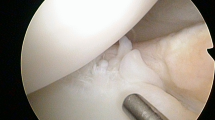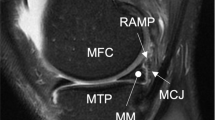Abstract
Purpose
Ramp lesions are common in ACL deficient knees. Their diagnosis is difficult and, therefore, they may be underestimated. So far, no study analyzed their prevalence in a pediatric population. The diagnosis of these Ramp lesions is of major clinical relevance because of a frequent misestimating and technic difficulties. Ramp lesions might be associated with residual knee pain and instability after ACL reconstruction. The aim of this study was to evaluate the prevalence of ramp lesions explored through a systematic intercondylar and posteromedial arthroscopic approach during an ACL reconstruction in a pediatric and adolescent population.
Methods
Children and adolescents who underwent an ACL reconstruction were screened prospectively between October 2014 and 2016. The presence or absence of a ramp lesion was evaluated after each of three arthroscopic steps: (1) an anterior approach, (2) an intercondylar inspection, and (3) a posteromedial approach. Ramp lesions were screened at each step and their prevalence was evaluated. Furthermore, their presence was correlated to age, weight, size, sex, and state of the physis (open or closed). Finally, the meniscal status on MRI and arthroscopic findings were compared.
Results
Fifty-six patients were analyzed. The median age was 14.0 ± 1.3 years (12–17). The median interval between injury and surgery was 11.5 months (1–108). During step 1 (anterior approach), only 1 ramp lesion (2%) was diagnosed. 13 (23%) ramp lesions were found after inspection through the intercondylar notch. No additional lesions were found with a direct view through the posteromedial approach. No correlation between ramp lesions and side, sex, weight, size, or state of physis was found. 10 ramp lesions out of 13 could not be diagnosed on MRI.
Conclusions
The prevalence of ACL-associated ramp lesions in children and adolescents is similar to adult populations. A systematic inspection through the intercondylar notch is recommended during ACL reconstruction to make a precise diagnosis. The posteromedial approach is essentially useful for meniscal repair
Level of evidence
Testing, previously developed diagnostic criteria in a consecutive series of patients and a universally applied “gold” standard, Level I.


Similar content being viewed by others
References
Smith JP 3rd, Barrett GR (2001) Medial and lateral meniscal tear patterns in anterior cruciate ligament-deficient knees. A prospective analysis of 575 tears. Am J Sports Med 29:415–419
Ahlden M, Samuelsson K, Sernert N, Forssblad M, Karlsson J, Kartus J (2012) The Swedish National Anterior Cruciate Ligament Register: a report on baseline variables and outcomes of surgery for almost 18,000 patients. Am J Sports Med 40:2230–2235
Granan LP, Ignacio MC, Maletis GB, Funahashi TT, Engerbretsen L (2012) Intraoperative findings and procedures in culturally and geographically different patient and surgeon populations: an anterior cruciate ligament reconstruction registry comparison between Norway and the USA. Acta Orthop 83:577–582
Ahn JH, Bae TS, Kang KS, Kang SY, Lee SH (2011) Longitudinal tear of the medial meniscus posterior horn in the anterior cruciate ligament-deficient knee significantly influences anterior stability. Am J Sports Med 39:2187–2193
Peltier A, Lording T, Lustig S, Servien E, Maubisson L, Neyret P (2015) Posteromedial meniscal tears may be missed during anterior cruciate ligament reconstruction. Arthroscopy 31:691–698
Bollen SR (2010) Posteromedial meniscocapsular injury associated with rupture of the anterior cruciate ligament: a previously unrecognized association. J Bone Joint Surg Br 92:222–223
Liu X, Feng H, Zhang H, Hong L, Wang XS, Zhang J (2011) Arthroscopic prevalence of ramp lesion in 868 patients with anterior cruciate ligament injury. Am J Sports Med 39:832–837
Robb C, Kempshall P, Getgood A, Standell H, Sprowson A, Thompson P, Spalding T (2015) Meniscal integrity predicts laxity of anterior cruciate ligament reconstruction. Knee Surg Sports Traumatol Arthrosc 23(12):3683–3690
Seil R, VanGiffen N, Pape D (2009) Thirty years of arthroscopic meniscal suture: what’s left to be done? Orthop Traumatol Surg Res 95:S85–S96
Sonnery-Cottet B, Contecuda J, Thaunat M, Gunepin FX, Seil R (2014) Hidden lesions of the posterior horn of the medial meniscus: a systematic arthroscopic exploration of the concealed portion of the knee. Am J Sports Med 42:921–926
Strobel (1988) Menisci. In: Fett HM, Flechtner P (eds) Manual of Arthroscopic Surgery. Springer, New York, pp 171–178
Thaunat M, Jan N, Fayard JM, Kajetanek C, Murphy CG, Pupim B, Gardon R, Sonnery-Cottet B (2016) Repair of meniscal ramp lesions through a posteromedial portal during Anterior Cruciate Ligament Reconstruction: Outcome study with a minimum 2-year follow-up. Arthroscopy. doi:10.1016/j.arthro.2016.02.026
Hash TW 2nd (2013) Magnetic resonance imaging of the knee. Sports. Health (London) 5:78–107
Bhatia S, LaPrade CM, Ellman MB, LaPrade RF (2014) Meniscal root tears: significance, diagnosis, and treatment. Am J Sports Med 42:3016
Moksnes H, Engebretsen L, Risberg MA (2013) Prevalence and incidence of new meniscus and cartilage injuries after a non-operative treatment algorithm for ACL tears in skeletally immature children: a prospective MRI study. Am J Sports Med. doi:10.1177/0363546513491092
Baxter MP (1988) Assessment of normal pediatric knee ligament laxity using the genucom. J Pediatr Orthop 8:546–550
Gillquist J, Hagberg G, Oretorp N (1979) Arthroscopic examination of the posteromedial compartment of the knee joint. Int Orthop 3:13–18
Chotel F, Henry J (2012) ACL reconstruction in children: an original technique. Tech Knee Surg 11:46–56
Henry J, Chotel F, Chouteau J, Fessy MH, Berard J, Moyen B (2009) Rupture of the anterior cruciate ligament in children: early reconstruction with open physes reconstruction to skeletal maturity? Knee Surg Sports Traumatol Arthrosc 17:748–755
Hamberg P, Gillquist J, Lysholm J (1983) Suture of old and new peripheral meniscus tears. J Bone Joint Surg Am 65-A:193–197
Stephen JM, Halewood C, Kittl C, Bollen SR, Williams A, Amis AA (2016) Posteromedial meniscocapsular lesions increase tibiofemoral joint laxity with anterior cruciate ligament deficiency, and their repair reduces laxity. Am J Sports Med 44:400–408
Allaire R, Muriuki M, Gilberston R, Harner CD (2008) Biomechanical consequences of a tear of the posterior root of the medial meniscus. Similar to a total meniscectomy. J Bone Joint Surg Am 90:1922–1931
Papageorgiou CD, Gil JE, Kanamori A, Fenwick JA, Woo SL, Fu FH (2001) The biomechanical interdependence between the anterior cruciate ligament replacement graft and the medial meniscus. Am J Sports Med 29:226–231
Song GY, Liu X, Zhang H, Wang QQ, Zhang J, Li Y, Feng H (2016) Increased medial meniscal slope is associated with greater risk of ramp lesion in noncontact anterior cruciate ligament injury. Am J Sports Med 44:2039–2046
Sharifah MI, Lee CL, Suraya A, Johan A, Syed AF, Tan SP (2015) Accuracy of MRI in the diagnosis of meniscal tears in patients with chronic ACL tears. Knee Surg Sports Traumatol Arthrosc 23:826–830
Author information
Authors and Affiliations
Corresponding author
Ethics declarations
Conflict of interest
SR, AP, CP, RS, and FC declare that they have no conflict of interest with this study.
Ethical approval
All procedures performed in this study involving human participants were in accordance with ethical standards of the institutional and/or national research committee and with the 1964 Helsinki declaration and its later amendments or comparable ethical standards.
Informed consent
Informed consent was obtained drom all individual participants included in the study.
Additional information
Hospices Civils de Lyon study number: 69HCL14.0358.
Declaration number on clinicaltrials.gov: NCT02425995.
Rights and permissions
About this article
Cite this article
Malatray, M., Raux, S., Peltier, A. et al. Ramp lesions in ACL deficient knees in children and adolescent population: a high prevalence confirmed in intercondylar and posteromedial exploration. Knee Surg Sports Traumatol Arthrosc 26, 1074–1079 (2018). https://doi.org/10.1007/s00167-017-4471-4
Received:
Accepted:
Published:
Issue Date:
DOI: https://doi.org/10.1007/s00167-017-4471-4




